Baz Luhrmann is one of my favorite writer-directors. In honor of him, I am going to be reviewing his first three films that later became known as The Red Curtain Trilogy. The films are not a traditional trilogy as they are not connected in plot or characters. They are connected in that each film opens and closes with a red curtain, takes a well-known myth or fable and sets it in a heightened creative world, and contains a theatre motif. Song is used in Moulin Rouge, poetry and language is used in Romeo + Juliet and dance is used in Strictly Ballroom which is the first in the trilogy and Baz Luhrmann’s first film.
Scott Hastings is one of Australia’s best ballroom dancers and has a great chance at winning the Pan-Pacific Grand Prix Dancing Championship. However, he jeopardizes his chances when he performs his own steps that are spontaneous and improvised. His partner becomes enraged and leaves him. His mother and dance coach are beside themselves at this turn of events. Only the kind hearted Fran believes in him and offers to become his partner despite her lack of experience.Working together, they soon develop a bond that goes beyond dancing.
RELATED Moulin Rouge Music Video: The Lonely
The fables Luhrmann takes elements from are David and Goliath and the Ugly Duckling. Luhrmann somehow manages to tell a familiar story but make it look fresh through flashy dance numbers, beautiful imagery and a quirky mockumentary interview style integrated into the narrative.
Despite its familiar plot, this romantic comedy has plenty of heart, energy and sweetness. One of the interesting aspects of this film is that Baz Luhrmann himself took ballroom dance classes as a child from his mother who was a ballroom dance teacher. The influence these experiences had on Luhrmann certainly show in the film as it is an amusing satire on the driven ballroom personalities, a loving tribute to the art, and a charming romantic fairy-tale all rolled into one.
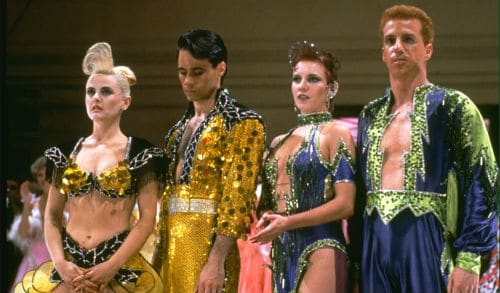
I really liked how dancing was used not just in a competitive sense but also to help tell the story. For example, one dance number involves Scott and Fran’s father which illustrates Scott meeting Fran’s family for the first time as well as helps move the story along. Another dance involves Scott and his first partner Liz. When she is about to walk out on him, Scott uses dancing to try to persuade her into staying. Their dance is used as both a conversation and a performance as they argue about Scott’s nontraditional steps.
Every person in the film takes the art/sport of competitive ballroom dancing with deadly seriousness and it is quite an interesting world to spend an hour and a half in. For the characters, it seems as if the world of ballroom dancing is used to escape from the outside world. Many of the characters, mainly veteran dancers and those who make the rules and are in charge of the competitions, are intensely terrified of change and have created a world with inflexible rules and traditions; here they can be in control, as the larger world delves into chaos. Music, dance and passion are viscerally integrated in the film, allowing the emotions of the viewers to go from comedic fantasy to deep pathos with emotional results.
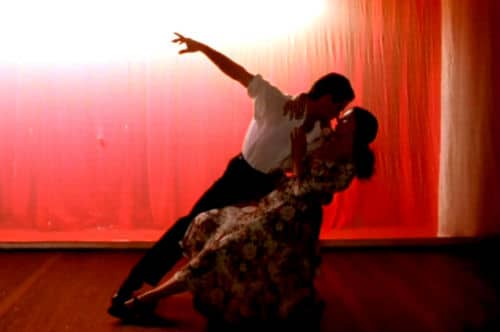
As with most of Luhrmann’s films, Strictly Ballroom is a feast for the eyes. The visuals are bold with prominent colors and fast and sharp cuts from dialogue scenes to more elegant shooting of the dance sequences. There are so many images and scenes that are burned into my memory for being so effective. One such scene is the opening. The red curtain parts and the audience is hurled into a whirlwind of colorful and flashy gowns (and sequins, so many sequins), stage smiles, spur-of-the-moment applause and the grandeur of Johann Strauss’ “The Blue Danube Waltz.”
Another memorable scene is when Scott and Fran are rehearsing by the clothes line in front of the giant sequin Coca Cola sign on the roof, while Scott’s father secretly dances in the studio below. Another great scene is when Fran and Scott dance together backstage and never tear away from each other’s gaze even as other people gather to watch them.
This was Luhrmann’s first film and, as the way of several first-time directors before him, is intoxicated with all of the different kinds of shots he can make with the camera. Some of these shots work, such as the focus on the feet when a character is learning a new kind of dance while some others not so much. In my opinion, he uses a few too many wide-angle shots, which do not flatter the actors in the least. Another problem I have is the fact that there are far too many subplots and at times it can be difficult to keep track of them all. However, despite these issues the movie is filled to the brim with enthusiasm and energy that cannot be faked.
Strictly Ballroom has many themes and messages. A powerful message is this: A life lived in fear is a life half lived. The main characters must take great risks to overcome their fears in the way that they dance, even if that means never winning. Without giving too much away, the audience gets to see the outcomes of what a life ruled by fear looks like and it is quite moving. The film is also about following your dreams and believing in yourself. Most importantly, it is about love and two young people fighting for artistic freedom against a repressive society. They are important messages and are worth telling.
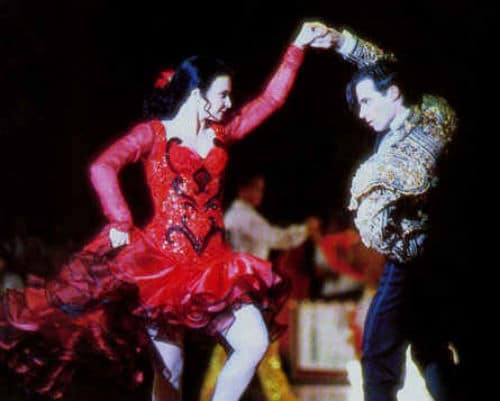
Though the characters are not the most original, they still have spirit and energy. Scott is a very talented and dedicated dancer. He has been dancing since he was six years old, working to win the Pan-Pacific Grand Prix Dancing Championship. However, his rebellious side cannot be contained and it is his passion for dancing that leads him to try his own steps. Such passion and dedication is admirable, I think. In the beginning of the film, he is a bit overbearing in his own right as well as arrogant. However, as Scott spends more and more time with Fran his character evolves, becoming more open minded and accepting. When Scott is dancing to satisfy the expectations of others, he is unhappy, but when he allows himself to express his creativity, he finds fulfillment and even love with Fran. Scott lives in a world where winning means everything. Throughout the film, he must learn how hollow victory can be if the end result is the stifling of creativity.
Fran is at first nervous and clumsy as she is still a beginner. Nevertheless, as she learns dancing from Scott, her confidence builds, her moves become graceful and full of life. The audience, as well as Scott, get to witness the bloom of a talented dancer with Spanish blood coursing through her veins. Another small detail I like was how her building confidence is symbolized through wardrobe, make up, and hair improvements but she is still Fran and I appreciate that. One of my favorite small moments in the film is a conversation Fran has with her grandmother about how confidence can create a beauty of its own. Fran becomes a strong-willed woman who speaks her mind and finds a balance between her family, her love for dance and her love for Scott. Personally, I really related to her character and I enjoyed watching her grow.

Scott’s mother is ambitious and hilariously overbearing. Mrs. Hastings was once a champion dancer and has been pushing her son to excel ever since he was a young child, wanting him to achieve the dreams she never could. She often puts on her ‘happy face’ when things are looking grim. She is determined for Scott to be a champion and cannot understand nor tolerates his desire to improvise in his dancing. Scott’s father is much more introverted, shy and docile. He also seems to be quite the dancer himself, though interestingly he only dances when he is alone.
Fran’s father and grandmother, on the other hand, are more sensitive and understanding of the young couple’s need to express their creativity than Scott’s family. Fran’s father, at first, seems very stern and strict. However, it comes from a place of love and protectiveness of his only daughter. He actually ends up helping his daughter and Scott in properly learning the “Pasa Doble.” Fran’s grandmother is kind and wise. She is also the one who convinces the father to teach Scott in the first place. It was interesting to watch the contrast of the two families both culturally and their respective philosophies of dance. The characters may not have oceans of depth but they are still entertaining and well defined.
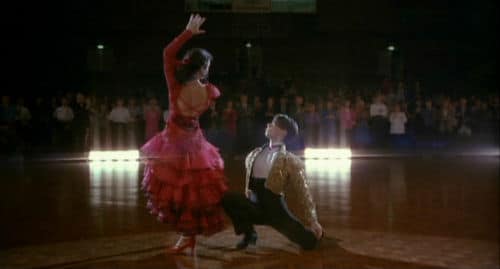
The cute love story between Scott and Fran makes the film very warm and inviting. Both of them are at home on the dance floor, as evidenced by their competence, energy and how well the two work together. I appreciated the slow buildup of their relationship through their dancing practice. It was very reminiscent to me of another dance film Dirty Dancing. Personally, I felt their connection and I wanted to see them together both on and off the dance floor. At the same time, the romance did take over the plot of the film which I also liked as the film has so much more going on than just the romance. As a side note, I am now going to forever associate Cindy Lauper’s “Time After Time” with Scott and Fran’s relationship. It just suits them so well and I love how they dance to it during rehearsals.
I recommend this film to those who enjoy Baz Luhrmann films and fans of ballroom dancing for the atmosphere, the costumes and the dancing itself. As well as anyone who likes a warm, sweet romance.
Overall Rating:
Romance Rating:
 “You pierce my soul. I am half agony, half hope.
“You pierce my soul. I am half agony, half hope.
I have loved none but you.”
ARE YOU A ROMANCE FAN? FOLLOW THE SILVER PETTICOAT REVIEW:
 Our romance-themed entertainment site is on a mission to help you find the best period dramas, romance movies, TV shows, and books. Other topics include Jane Austen, Classic Hollywood, TV Couples, Fairy Tales, Romantic Living, Romanticism, and more. We’re damsels not in distress fighting for the all-new optimistic Romantic Revolution. Join us and subscribe. For more information, see our About, Old-Fashioned Romance 101, Modern Romanticism 101, and Romantic Living 101.
Our romance-themed entertainment site is on a mission to help you find the best period dramas, romance movies, TV shows, and books. Other topics include Jane Austen, Classic Hollywood, TV Couples, Fairy Tales, Romantic Living, Romanticism, and more. We’re damsels not in distress fighting for the all-new optimistic Romantic Revolution. Join us and subscribe. For more information, see our About, Old-Fashioned Romance 101, Modern Romanticism 101, and Romantic Living 101.


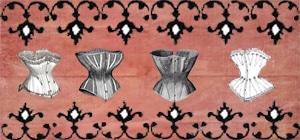
Comments are closed.